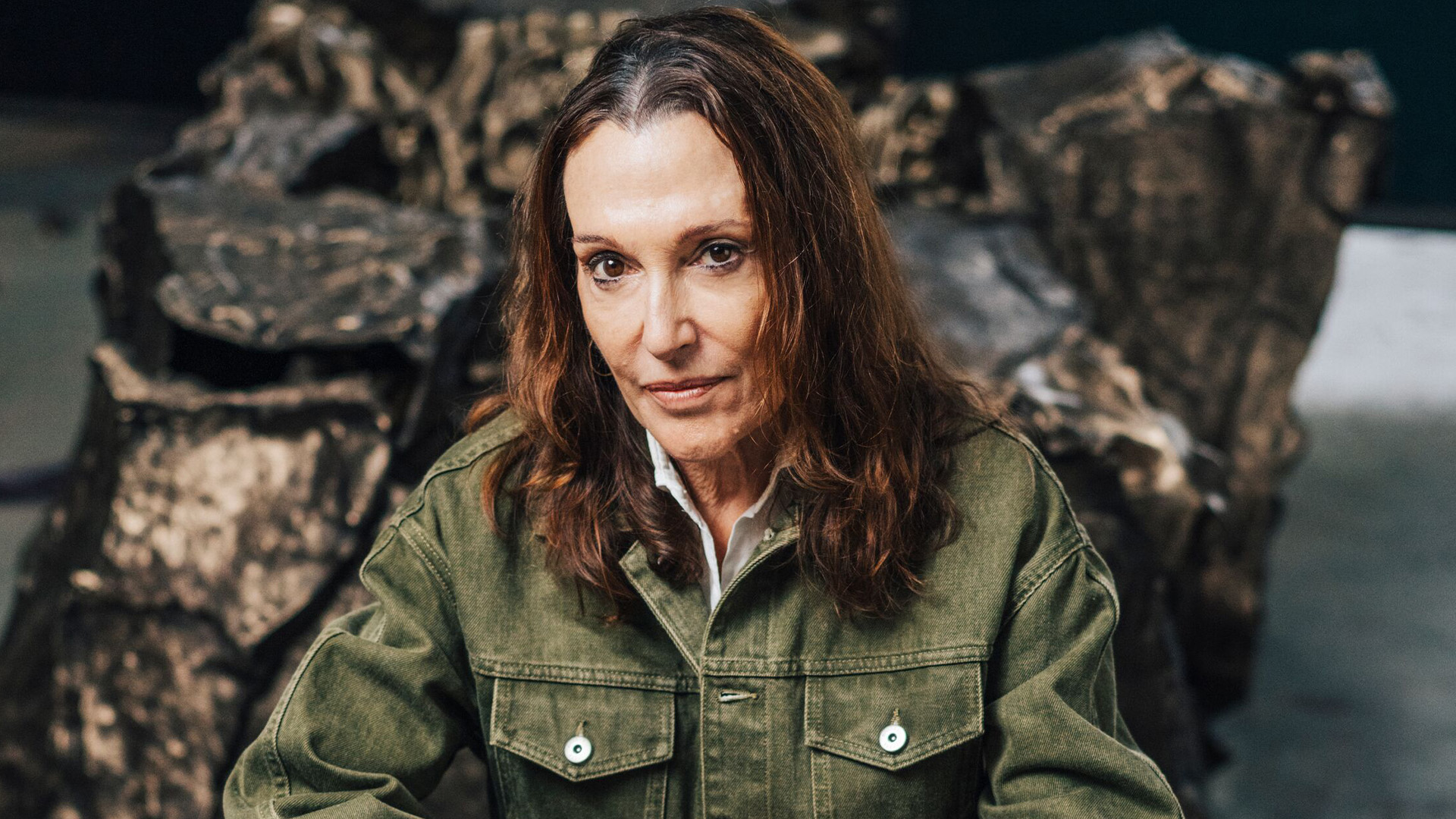Teachers’ Notes: ‘Amy Sherald. The World We Make’

Amy Sherald, 2022 © Amy Sherald. Photo: Adam Kremer
Teachers’ Notes: ‘Amy Sherald. The World We Make’
This resource has been produced to accompany the exhibition ‘Amy Sherald. The World We Make’ at Hauser & Wirth London from 12 October through 23 December 2022.

Vanity Fair cover, September 2020
‘I’ve had conversations with other artists who feel as if their work has to create teaching moments about history and our struggle. But I wonder, when do we breathe? There has to be room for a range of experiences, because if there isn’t, how do we evolve?’—Amy Sherald, 2021 [1]
About Amy Sherald
Amy Sherald is an American portraitist who documents contemporary African American experience in the United States through figurative paintings of Black people in straightforward portraits, moments of leisure or direct art historical references. She is known for her bright colors and spectacularly meticulous details, and for using a grisaille palette to render the skin tones of her sitters. Sherald engages with the history of photography and portraiture, inviting viewers to participate in a more complex debate about accepted notions of race and representation, and to situate Black heritage centrally in American art.
Born in Columbus, Georgia in 1973, Sherald was interested in painting and visiting museums from a young age. Sherald’s parents wanted her to study medicine rather than pursue a career in art, yet she remained interested in painting. She obtained her undergraduate degree in painting at Clark-Atlanta University in 1997 and a Master of Fine Arts in Painting from the Maryland Institute College of Art in 2004. Sherald was the first woman and first African American to ever receive the grand prize in the 2016 Outwin Boochever Portrait Competition from the National Portrait Gallery in Washington DC. She also received the 2017 Anonymous Was A Woman Award and the 2019 Smithsonian Ingenuity Award. In 2018, Sherald was selected by First Lady Michelle Obama to paint her portrait as an official commission for the National Portrait Gallery in Washington DC.
After the death of Breonna Taylor in 2020, Sherald was commissioned to paint a portrait of Taylor which is jointly owned by the Smithsonian National Museum of African American History and the Speed Art Museum in Taylor’s hometown of Louisville, Kentucky. Through this sale, Sherald donated $1 million to create a trust for the long-term funding of the Breonna Taylor Legacy Fellowship and the Breonna Taylor Legacy Scholarship. These two scholarships will be awarded to law students and undergraduates at the University of Louisville who express an interest in public policy.
Sherald’s work is held in public collections such as the Whitney Museum of American Art, New York NY; the Los Angeles County Museum of Art, Los Angeles CA; Museum of Fine Arts Boston, Boston MA; the Crystal Bridges Museum of American Art, Bentonville AR; Embassy of the United States, Dakar, Senegal; Smithsonian National Museum of African American History and Culture, Washington DC; Smithsonian National Portrait Gallery, Washington DC; and Nasher Museum of Art, Durham NC.

Amy Sherald, Kingdom, 2022 © Amy Sherald. Photo: Joseph Hyde
What are the major themes within the exhibition?
Art History and Black Representation
Sherald’s paintings depict figures whose demeanours are both proud and relaxed, seemingly asking the audience to imagine the internal personhoods that are being portrayed. Her smaller portraits are always installed at a height that allows viewers to come face-to-face with the painted figures. In certain works, Sherald reframes famous historical imagery, and in doing so, she reimagines the historical moment.
She is acclaimed for her paintings of Black Americans at leisure that have become landmarks in the grand tradition of social portraiture—a tradition that for too long excluded the Black men, women, families and artists whose lives have been inextricable from public and politicised narratives. Sherald foregrounds the idea that Black life and identity are not solely tethered to grappling publicly with social issues and that resistance also lies in an expressive vision of self-sovereignty in the world. By subverting existing narratives, Sherald hopes to offer the viewer a reflection of themselves and the complexities of their interior lives, void of the constructs of race, gender, religion and preconceived notions.
‘For love, and for country’ (2022) depicts two Black males embracing each other, replicating the famous photo taken in 1945 on V-J Day in Times Square. ‘Kingdom’ (2022) depicts a young person on top of a slide who replicates the pose from Caspar David Friederichs’ work ‘Wanderer above the Sea of Fog’ (1818). Sherald is purposely reframing historical narratives in order to expand upon historical moments by imagining a more inclusive world.
Photography and Portraiture
Discussing the importance of photography in her work, Sherald shares, ‘I don’t see images like mine coming from the lineage of European painting; when the camera was invented, we eventually were able to become authors of our own narratives…We got to say, ‘This is how I want to be represented and this is how I want to be seen.’ [2] Sherald recognizes the history of photography as it relates to the Black identity, specifically how the camera was an important tool allowing Black individuals to gain ownership of their stories through controlling their self-representation, such as determining their mode of dress and appearance. For her London exhibition, ‘The World We Make,’ Sherald states, ‘Sharing these paintings in Europe is an opportunity for me to reflect on how the tradition of portraiture finds continuity as one of several lineages alive in my work.’ [3]
The Performance of Masculinity
Sherald challenges historical narratives that have excluded Black personhoods and narratives. Sherald expands the public’s imagination on the subject of masculinity through the painting ‘For love and for country’ (2022) and states, ‘I was thinking about the history behind the photograph and the Black soldiers who returned from the war shortly after, and what it would mean to broach the iconic pose through another understanding of masculinity.’ [4]
Clothing
The clothing of the sitters in Sherald’s work are often vivid and bold, standing as integral components to Sherald’s narratives. Sherald searches for clothing before she embarks on the paintings. Although the clothing colors and patterns are particularly striking against the monochromatic backdrops, the personhoods and energies of the individuals wearing the clothing seem to emphasize the style and soul of the outfits.

Amy Sherald, For love, and for country, 2022 © Amy Sherald. Photo: Joseph Hyde
What does the exhibition look like?
Featuring a series of small-scale and monumental portraits across both the gallery’s London spaces, this presentation is the artist’s largest to date with Hauser & Wirth and marks the artist’s first solo show in Europe.
In this new body of work, Sherald humanises the Black experience by depicting her subjects in both historically recognisable and everyday settings, at once immortalizing them and reinserting them into the art historical canon.
Sherald discusses a prominent moment in which one of her purposes of being a contemporary painter was brought to light and states, ‘At an opening of mine in 2015, a young woman and her daughter came in—they were looking at one of the paintings and the daughter said, ‘I see my grandmother.’ She had never seen a portrait of a Black person in a gallery before. I was reminded, this is why I do what I do.’ [5]

Installation view, ‘Amy Sherald. The World We Make,’ Hauser & Wirth London, 2022 © Amy Sherald. Photo: Alex Delfanne
What other artists does her work relate to?
Bo Bartlett (born 1955) is an American realist painter who portrays elements of everyday life in America.
Anna Julia-Cooper (born 1858) was an American author, educator, sociologist, Black liberation activist and scholar.
Kerry James Marshall (born 1955) is an American artist and professor whose work depicts Black figures and identities.
Tyler Mitchell (born 1995) is an American photographer and filmmaker whose work concentrates on the reimagination of Black Life and Black Beauty, emphasizing empowerment, play and self-determination.
Thomas J Price (born 1981) is a British artist who works across disciplines, predominantly in sculpture, but also in film and photography. Conceptually focused, Price engages with issues of power, representation, interpretation and perception both in society and in art.
Kara Walker (born 1969) is an American contemporary painter, silhouettist, printmaker, installation artist, filmmaker, and professor exploring race, gender, sexuality, violence and identity through her work.
Deborah Willis (born 1948) is a contemporary photographer, curator of photography, photographic historian, author and educator. She has focused on cultural histories revolving around the Black body, women and gender.

Installation view, ‘Amy Sherald. The World We Make,’ Hauser & Wirth London, 2022 © Amy Sherald. Photo: Alex Delfanne
GLOSSARY
American Realism
American realism was a movement in art, literature and music which showed contemporary social realities and people’s everyday lives.
Canon
A set of criteria by which something is judged.
Greyscale or Grisaille
A range of grey shades from white to black.
Immortalizing
To give someone or something praise or fame to create space for remembrance.
Leisure
A period of free time for relaxation and enjoyment.
Masculinity
Qualities or characteristics that have historically been attached to men.
Monochromatic
Something that depicts only one color.
Northern Renaissance Portraiture
Paintings that were created between the 15th and 17th Centuries, during the Renaissance period where artists painted complex details of their subject.
Nuanced
Characterized as having complex and subtle meanings.
Oil Painting
A process of painting that uses drying oil to bind various pigments together.
Portraiture
The art of painting or taking portraits which focus on the details of an individual.
Public Policy
An institutionalized proposal or set of principals which social laws are based on.
Representation
The portrayal or description of someone or something in a particular way.
Self Determination
The process by which an individual takes control of their own life.

Installation view, ‘Amy Sherald. The World We Make,’ Hauser & Wirth London, 2022 © Amy Sherald. Photo: Alex Delfanne
Questions for Discussion
How can today’s generation of contemporary artists take inspiration from Amy Sherald’s artistic process relating to the intersections of photography and painting?
How does portraiture expand how we see and imagine other people and how we see and imagine ourselves?
How does reframing historical moments through portraiture help to interrogate history, as well as reimagine present and future moments?
How does Sherald’s documentation of Black personhoods in America speak to the documentation of Black-British personhoods in the UK?
Choose a painting in the exhibition that you connect to; Who do you think this person is? What do you think they may be feeling? Does the work remind you of yourself or someone you know?
Practical Activities
Create a portrait of a close friend or family member using mediums such as photography, painting or drawing. What attitudes do you think are expressed through your portrait? What were you trying to capture when you created the portrait? Does the portrait reflect the complexities of the individual’s personality and identity? How so?
Choose one of Amy Sherald’s portraits and think about the colors and details of her work. Now create a drawing or a collage that reflects your own identity and how you see yourself. What types of colors or symbols would you add? Why?

Amy Sherald, As soft as she is…, 2022 © Amy Sherald. Photo: Joseph Hyde
Supplementary Research
Art in America Interview: The Epic Banal
Hauser & Wirth: Amy Sherald Artist Page
Hauser & Wirth: ‘Amy Sherald. The Great American Fact’, 2021
Hauser & Wirth: Amy Sherald at Contemporary Art Museum St. Louis
Hauser & Wirth: Amy Sherald: In the Studio Video
The Art Newspaper: News Article
[1] Amy Sherald, The Epic Banal (Art in America, 2021) [2] Ibid. [3] Amy Sherald, Black Napoleon and smooching sailors: Amy Sherald tells us about her first solo European show opening in London (The Art Newspaper, 2022) [4] Ibid. [5] Amy Sherald, The Epic Banal (Art in America, 2021).
Resources
1 / 10









